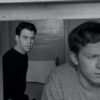All our SXSW 2012 coverage can be found here.
It stands to reason that most people who go to see “Last Call at the Oasis” will already be interested in the global water crisis, which makes its initial approach that feels akin to being accosted on the street by a Greenpeace volunteer less violent. Amiable and full of energy, it wants to tell you everything before you might pull away, unleashing a torrent of imagery in third world countries suffering from water-bourne illnesses and throngs of people waiting for clean water before dropping the bomb it could soon enough be us in America, a place represented cinematically by children innocently pouring water over their heads while Pink's garish party anthem "Raise Your Glass" booms in the background.
Though “Last Call” opens with a solemn story from Erin Brockovich, it quickly finds a more kindred spirit in Jay Famiglietti, (a professor at UC Irvine) who is able to say “We’re screwed” with a smile after telling students the day may be coming where Northern California gets no snow. Whether it’s a nervous tic or incredulity at such earth-shattering news or most likely a bit of both, it’s the kind of mixed signal that defines “Last Call at the Oasis” in the early going, making clear that it's a piece of activism with serious intent, but really, it can let its hair down too. There are reminders of this throughout the film – an unfortunate detour involving Jack Black becoming a spokesman for a fictional company selling recycled water feels belabored and hopelessly out of place – but like the well-meaning guy or gal with a clipboard outside the mall, if you’re patient with “Oasis” long enough, the frantic pitch begins to settle into a more reasonable discussion of its cause.
Perhaps the frenzy is because director Jessica Yu has never had such resources at her fingertips before or tackled something so broad. While her previous documentaries “In the Realms of the Unreal,” “Protagonist” or her Oscar-winning “Breathing Lessons” all benefitted from the intense focus on a specific subject matter, it seems as if the issue of the depleting water supply around the globe was considerably more difficult to harness. Yu has the wherewithal to travel all over, from Australia where drought has led to farmer suicides and red skies tinted by the dirt to the Gaza Strip where Palestinians, Israelis and Jordanians may not agree on anything else, but can form a coalition to keep the water in the Jordan River sacred. However, it isn’t until she reaches Midland, Texas and Leonidas, Michigan midway through the film where the film finds its groove, the shots finally lasting longer than five seconds and allowing the human factor to transcend the razzle dazzle technology can provide such as titles that rise of out topography and supercut editing.
There are two heroes that emerge in the Midwest, one of whom was a movie star by proxy already. In George W. Bush’s hometown in Texas, Brockovich has come to organize the community against the lax regulations, particularly “the Halliburton loophole” in the Safe Water Act, which have led to water contamination involving the cancer-causing Chromium Six, the same chemical that plagued the town of Hinkley, California which was depicted in the Steven Soderbergh film. (It’s noted that it wasn’t completely eradicated there.) Meanwhile, up north, Sierra Club member Lynn Henning becomes a literal muckraker, or as she’s been dubbed by locals “Pooperazzi,” for chronicling the abuses of a local CAFO (Concentrated Animal Feeding Operation) that dumps cows’ waste directly into the nearby waterways. Both have the charisma that only those who pick themselves up by the bootstraps can, and as Brockovich tells concerned citizens, “Superman is not coming,” referring to government intervention, so personal responsibility will need to trump corporate irresponsibility.
That opens up an affecting third act for “Last Call at the Oasis” which refreshingly proposes workable solutions to many of the problems it outlines in its first hour. Although on that score, it all depends on if the right people see it, and the filmmakers try mightily to ensure it by posting a Web site and even a number to text over the end credits, there’s enough compelling about the cross-cultural journey Yu takes the audience on to be of interest even if there is none in dialing up those digits after leaving the theater.
As Brockovich says, “When you see it all at once, it’s an eye-opener” and ultimately “Last Call at the Oasis” is too well-constructed and relevatory to disagree.
"Last Call at the Oasis" plays twice more at SXSW on March 14th at 11 a.m. at the Paramount Theater and March 15th at 2 p.m. at the Alamo Lamar B. It begins a national theatrical rollout on May 4th.


